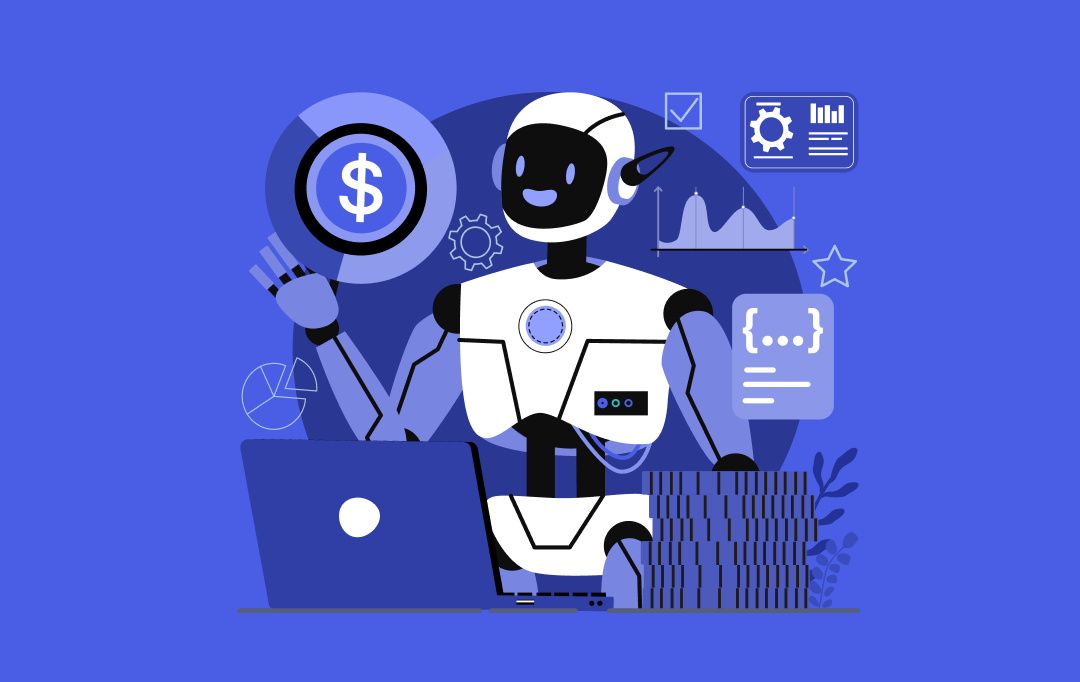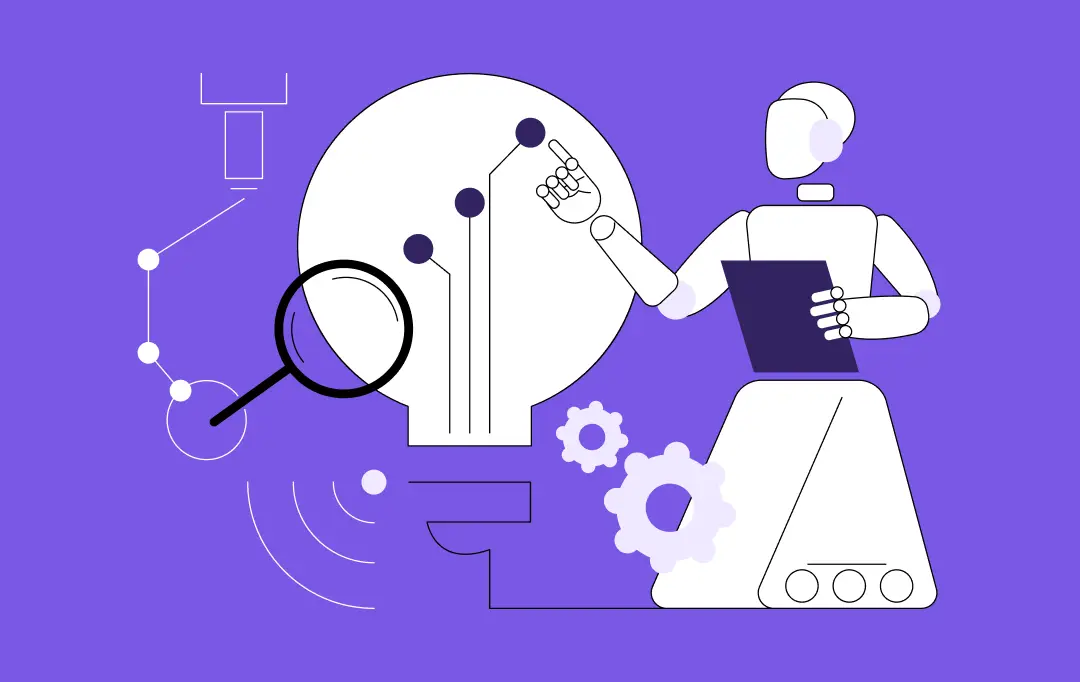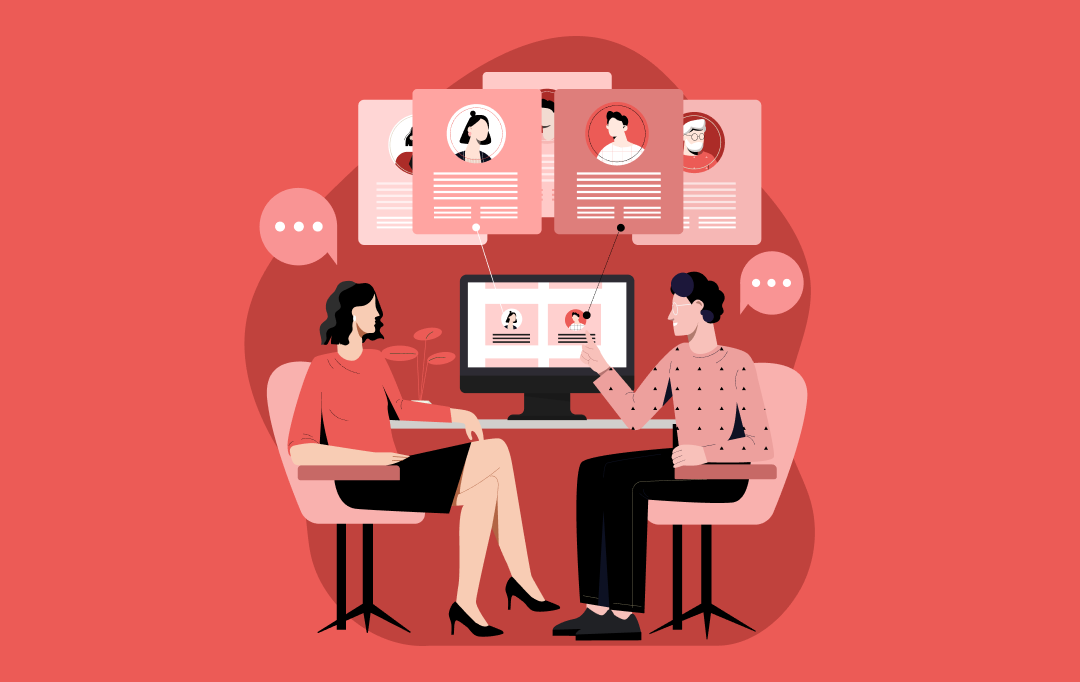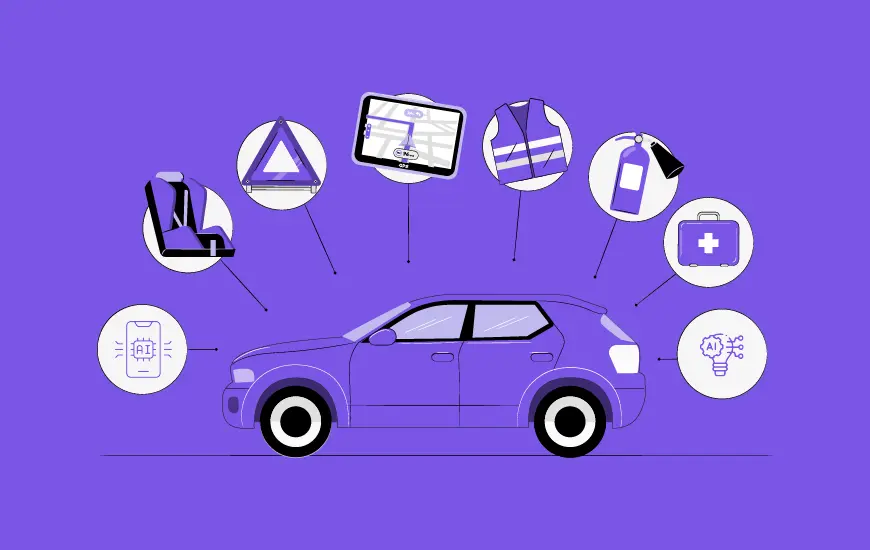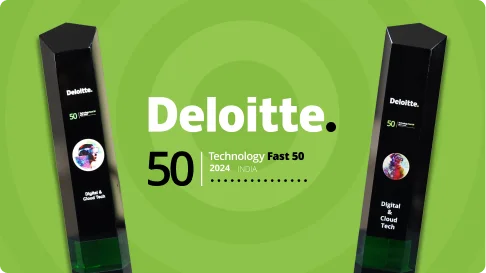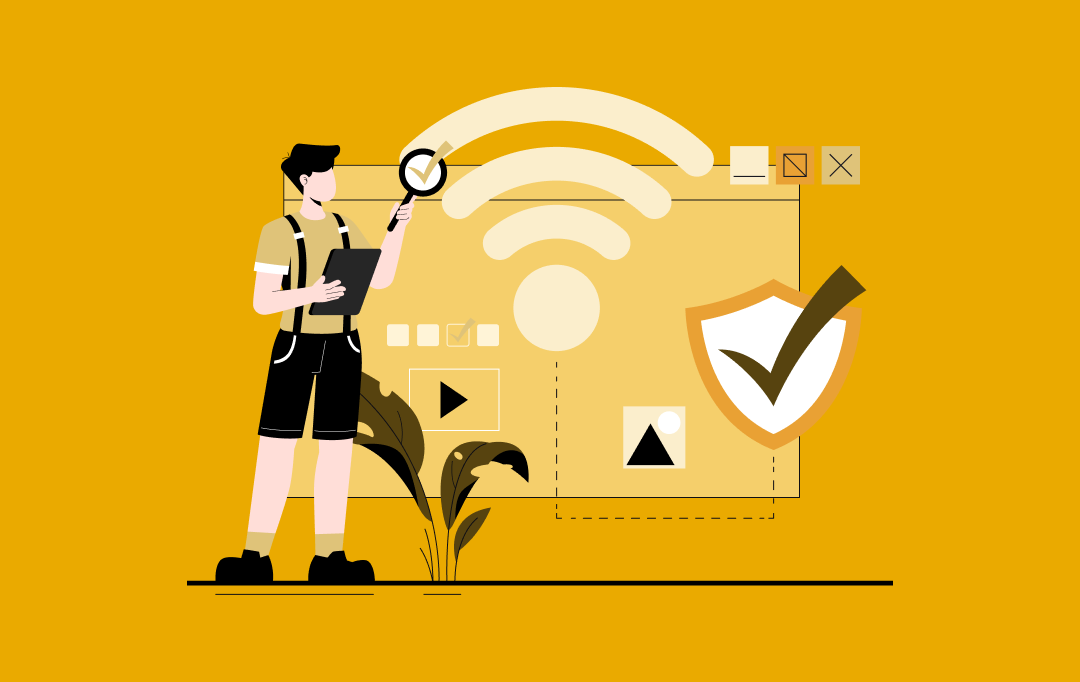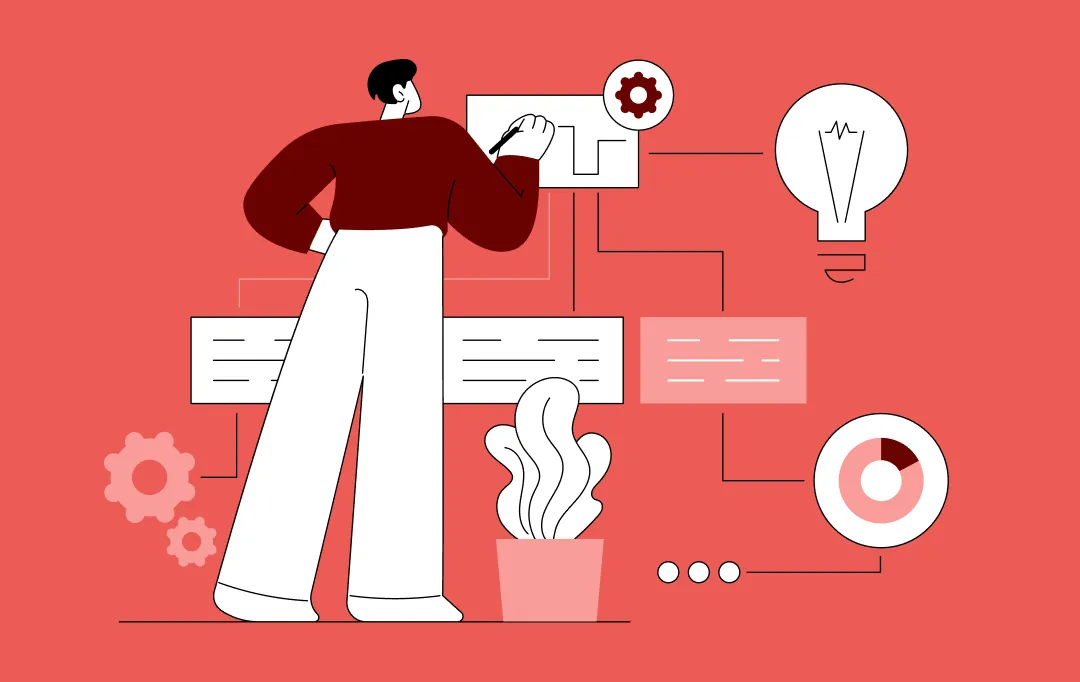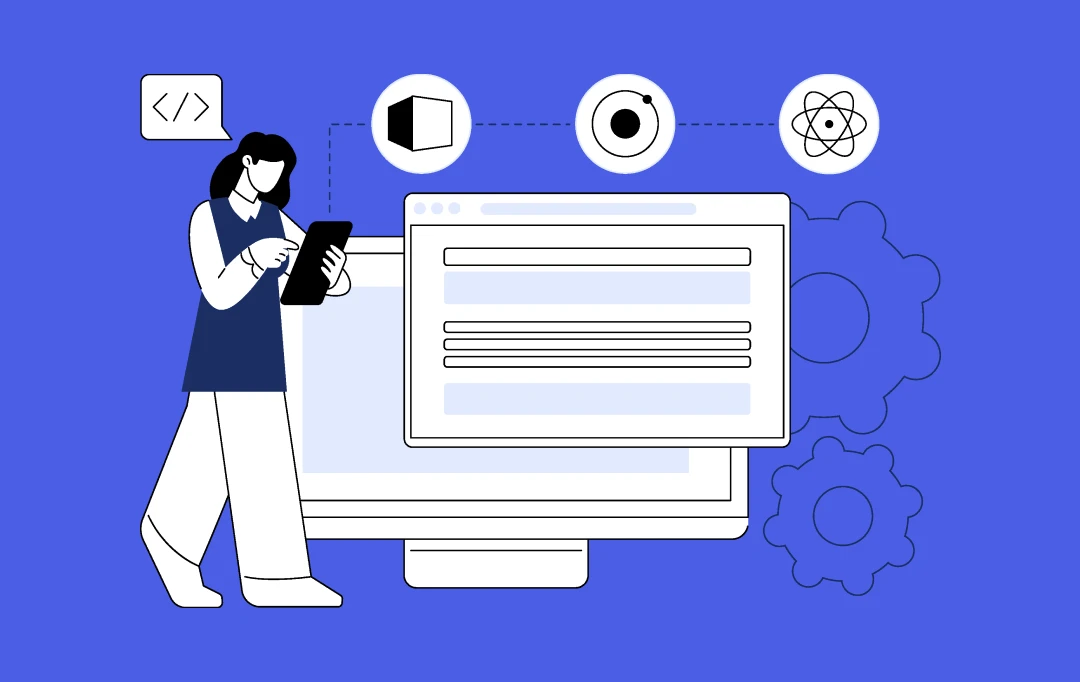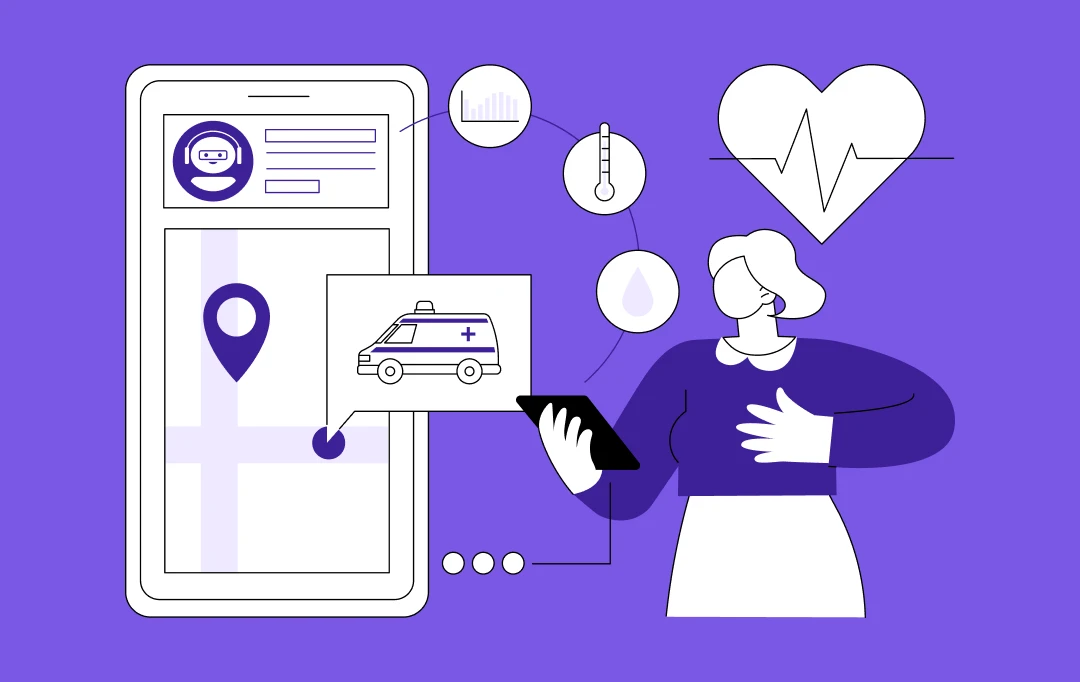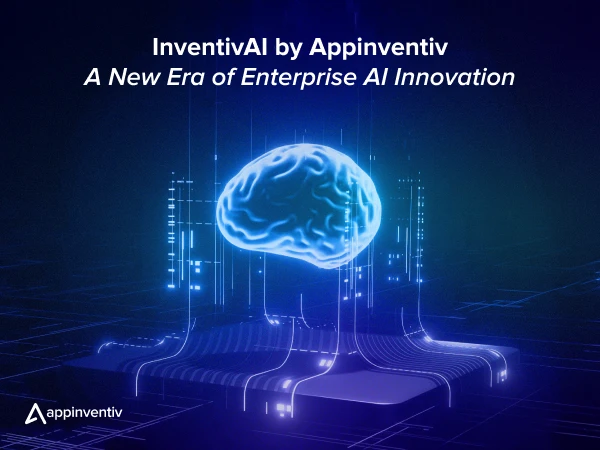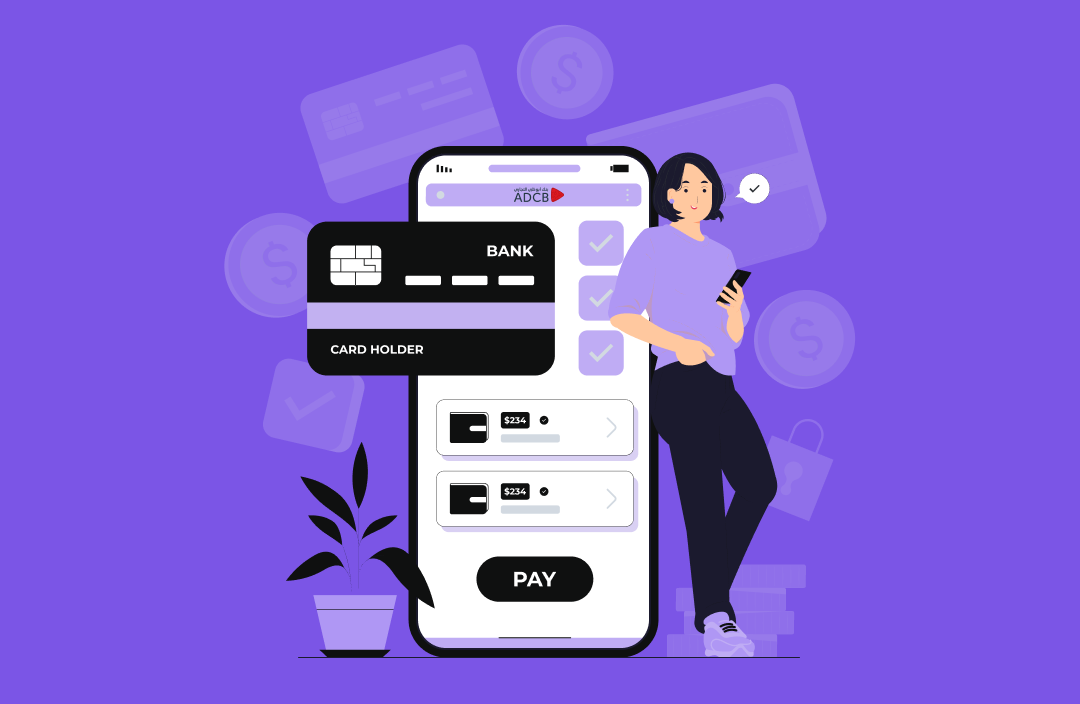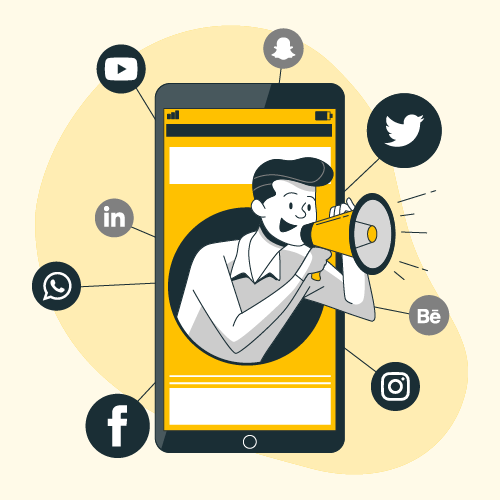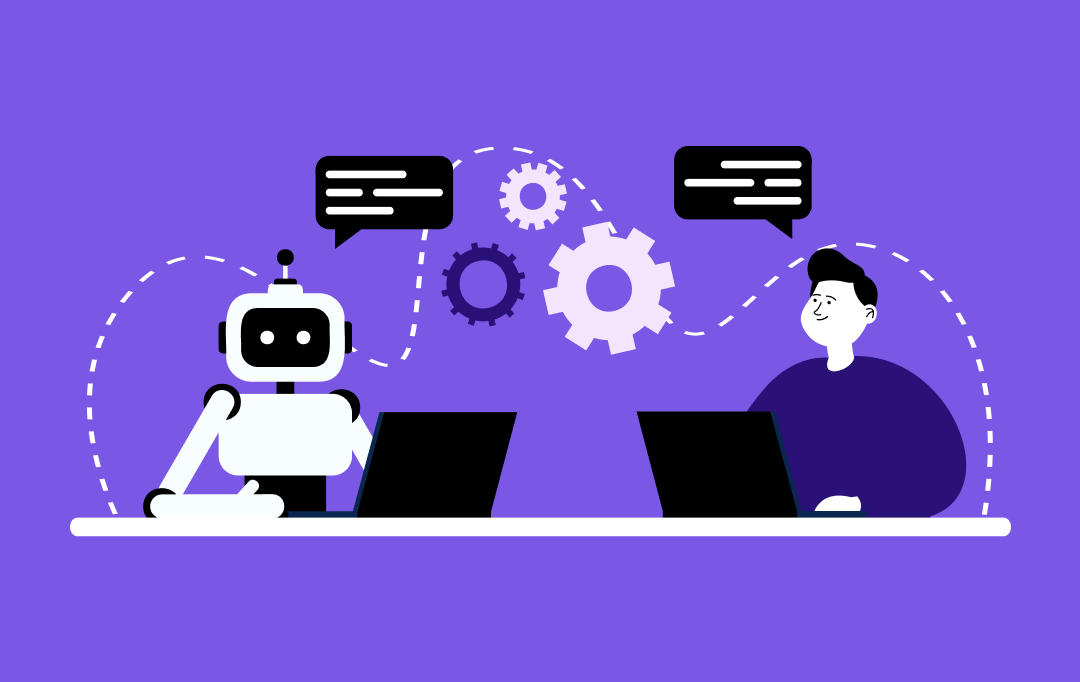- Understanding the Impact of Digital Twins in Healthcare
- Key Components of a Healthcare Digital Twin
- Data Ecosystem
- Integration and Interoperability Layer
- Analytical and Modelling Framework
- Real-Time Connectivity
- User Interface and Decision Layer
- Security and Governance Structure
- Computing and Infrastructure Support
- Types of Digital Twins in Healthcare
- Patient/Person or Body System Digital Twins (Autonomous Digital Twins)
- Surgical Digital Twins
- System Digital Twins
- Cellular & Molecular Digital Twins
- Process Digital Twins
- Organ or Smaller Unit Digital Twins
- Population Health Digital Twins
- Progressive Digital Twins
- Static Digital Twins
- Key Technologies Used in Digital Twins for Healthcare
- Use Cases of Digital Twins in Healthcare
- Clinical Trials and Drug Discovery
- Patient Remote Monitoring
- Customized Medicine
- Surgery Planning
- Epidemic Management
- Prosthetics and Implants
- Medical Device Development
- Hospital Operations
- Advanced Digital Twin Use Cases in Healthcare
- Bio-Manufacturing
- Individualized Homeostasis Monitoring
- Cancer Management
- Cardiovascular Disease
- Immune Responses
- Real-World Examples of Digital Twins in Healthcare
- 1. Babylon Digital Twin for e-medical Records
- 2. Hospital Ward Management Digital Twin at Mater Hospital, Dublin
- 3. Mayo Clinic’s Digital Twin for Precision Cancer Treatment
- 4. Stanford University’s Digital Twin for Cardiovascular Research
- 5. GE Healthcare’s Digital Twin for Predictive Equipment Maintenance
- 6. Imperial College London’s Digital Twin for Advanced Surgical Planning
- 7. Roche’s Accu-Chek Digital Twin for Smart Diabetes Management
- Advantages of Digital Twins Technology in Healthcare
- Enhanced Patient Care
- Predictive Maintenance
- Research and Development
- Optimization of Healthcare Systems
- Proactive Maintenance of Medical Equipment
- Immersive Training & Medical Education
- Advancing Medical Research & Drug Discovery
- Early Disease Detection & Prevention
- How are Digital Twins Created in Healthcare?
- Defining the Scope
- Collecting and Preparing Data
- Constructing the Model
- Supporting Real-Time Updates
- Validating and Refining
- Challenges of Adopting Digital Twin Technology in Healthcare
- Security and Compliance
- Data Accuracy and Completeness
- Interoperability Challenges
- Scaling Implementation
- Ethical Considerations
- Computing Infrastructure
- Business Models and ROI Uncertainty
- The Future of Digital Twin Technology in Healthcare
- AI-Driven Surgical Digital Twins with Haptic Feedback
- Pandemic Simulation & Biothreat Preparedness
- Digital Twin-Powered Metaverse for Virtual Healthcare
- Predictive Maternal & Neonatal Digital Twins
- Mental Health Digital Twins for Cognitive Therapy
- Genome-Twin Integration for Predictive Genomics
- Let Appinventiv Be Your Partner in Digital Twin Adoption
- FAQs
Key Takeaways
- Digital twins generate virtual representations of patients, through which healthcare providers can simulate treatment and forecast outcomes, leading to improved and more accurate personalized care.
- Digital twins can be used to reduce downtime, enhance equipment allocation, and simplify workflows and operations to offer hospitals better patient experiences, as they model the workflows and monitor equipment in real-time.
- Digital twins enable the quick and safe testing of drugs, clinical trials, and medical device development in a virtual space.
- Effective application of digital twins requires robust data security, interoperability, and scalability strategies to ensure their use is ethical and effective in healthcare systems.
Digital twins are just one of the innovative technologies that are truly changing the healthcare world, and fast. These virtual copies are actually super important for adopting better practices in the healthcare industry; they help medical organizations, which in turn improve patient care.
Take, for example, the major step forward Johns Hopkins University made. They were pioneers when they created a digital twin technology with the first virtual heart model approved by the FDA. This specific digital twins healthcare model lets doctors run precise simulations of how a patient’s heart acts. So, what does that mean? It means doctors can customize treatments and predict patient outcomes with much better accuracy.
This kind of innovation uses tools, including high-performance computing and neural networks, but the result is simple: a major move toward individualized healthcare here in the United States. It helps cut back on the old trial-and-error approach and improves the way clinical decisions get made.
The phenomenal exponential growth year after year is truly an amazing feat. Moreover, reports also suggest that the digital twin technology market is set to grow by nearly 60% each year, paving the way for substantial expansion by 2027 (Source: McKinsey). Such faith in digital twins’ ability is proof of the amazing benefits these innovative technologies bring to patient care and operational management.
It should be noted that this trend is not just temporary but an absolute change in the technological influence on health management. This article will explore the importance of digital twins in healthcare, highlighting the benefits, possibilities, and challenges.
Understanding the Impact of Digital Twins in Healthcare
In healthcare, computer models that mirror real patients, hospital systems, physical assets, and clinical processes are known as digital twins. Their digital equivalents include electronic health records (EHRs), disease registries, omics data, such as proteomic, genomic, metabolomic, and bionic data, as well as demographic and lifestyle data of an individual.
The accelerated progress of healthcare IoT and AI, in addition to the growing access to multidimensional data, such as behavioral, biometric, cognitive, emotional, and psychological data, has contributed to the growth of digital twins in healthcare. More accurate simulations, predictive analytics, and live monitoring can be achieved using these technologies, which will lead to more efficient and personal healthcare solutions.
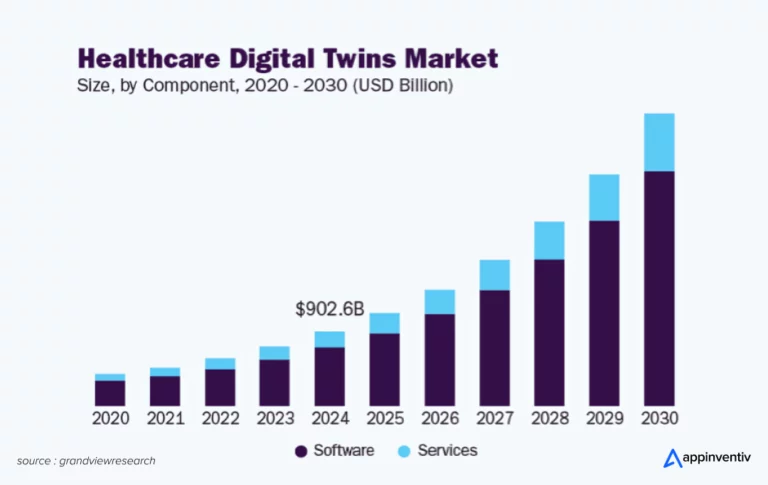
As per GVR’s report, the digital twins healthcare market is expanding rapidly, and in 2030, the sales are expected to reach $3.55 billion. This surge is supported by the rising demand for personalized medicine, predictive analytics, and the implementation of digital health solutions in the entire industry.
Medical digital twins have the potential to transform the management of lifestyle, tracking of wellness, and treatment of chronic diseases when properly leveraged. With constant updating of the virtual models with real-time signals of wearable devices, mobile health applications, and self-reported patient data, the digital twins can deliver a greater understanding of individual health trends.
This improved knowledge of the place of digital twins in healthcare will allow practitioners to design more precise treatment protocols, offer personalized advice, and eventually expand patient outcomes on a large scale.
Key Components of a Healthcare Digital Twin
A strong digital twin system needs several pieces to work together and truly capture clinical, operational, and environmental reality. These parts are what make a model that can support reliable decisions in all kinds of care settings.
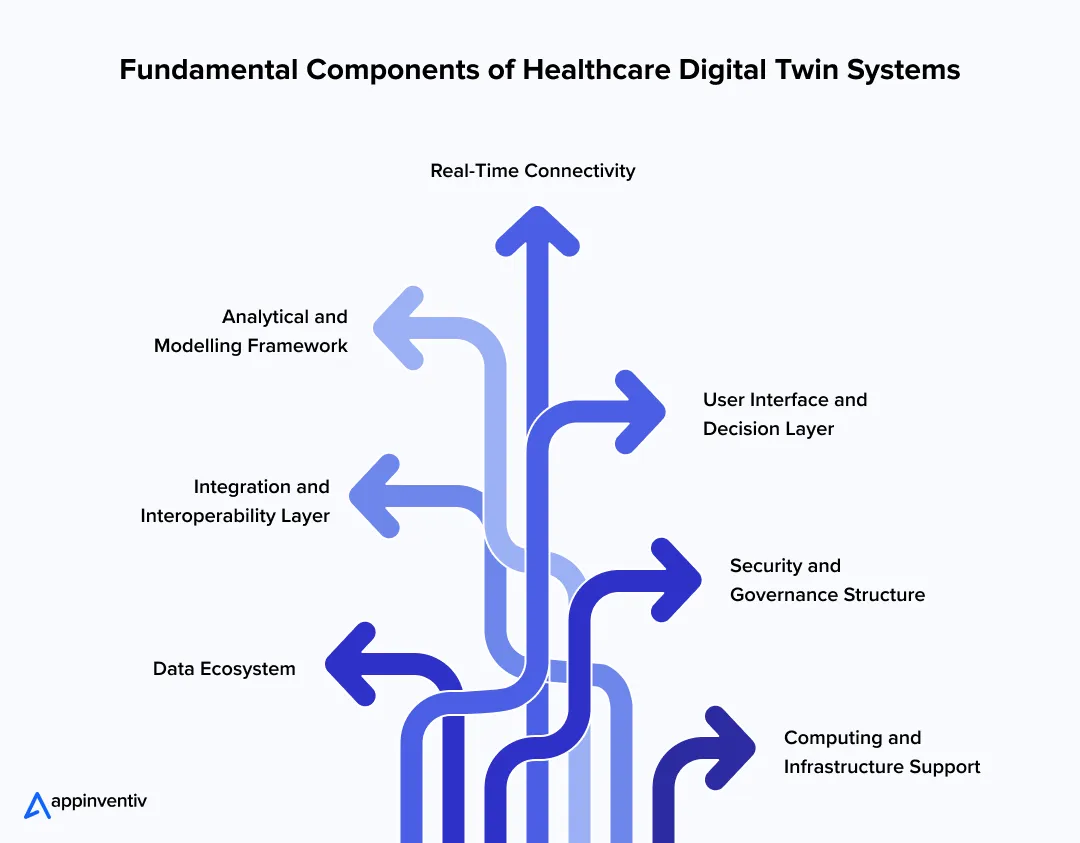
Data Ecosystem
A strong foundation starts with structured information. This comes from patient records, imaging systems, those monitors right next to the bed, lab platforms, and environmental sensors. These sources offer clear clinical and operational facts that can make an accurate model.
This step is absolutely vital when we’re designing a digital twin for healthcare use cases that demand consistent, high-quality inputs.
Integration and Interoperability Layer
This layer is the connector. It gathers information from all those different systems and gets it ready for unified analysis. It fixes formats, sorts out conflicts, and keeps the data flowing smoothly between platforms without interruption. A dependable integration structure gives the twin a stable, single view of the entire organization.
Analytical and Modelling Framework
This component is where the internal logic of the model is actually built. It uses statistical rules, physics-based behavior, or machine learning. It’s the part that interprets patterns found in the prepared data and then reacts to changes in real conditions.
This framework becomes especially valuable when we’re representing human digital twins in healthcare, where biological and behavioral factors must be modeled very carefully.
Real-Time Connectivity
Continuous updates are a must. They let the model adjust to new readings, shifts in workflow, or changes in a patient’s status right away. This constant connection transforms the twin from a static thing into an active tool used for monitoring, catching issues early, and planning operations. This makes sure the system stays relevant during the day-to-day work.
User Interface and Decision Layer
Clinicians and operational teams get access to the twin through dashboards and scenario tools. These interfaces take complex information and turn it into practical insight, making it easier to test out potential outcomes before they actually take action. This layer is what boosts the usefulness of digital twins in healthcare applications that support the human decision-making process.
Security and Governance Structure
It is essential to protect sensitive records, manage access to information, and maintain careful oversight of ethical practice over the long term. Governance policies ensure that compliance requirements are met, data integrity is preserved, and responsible use is upheld throughout the organization.
Computing and Infrastructure Support
You need high-performance processing, reliable storage, and solid networks to keep the model running in real time. Cloud computing healthcare services, edge devices, and distributed methods help manage heavy workloads as the system inevitably gets bigger and more complex. This backbone is what guarantees steady performance no matter what’s going on.
Types of Digital Twins in Healthcare
The use of digital twin in the healthcare industry can be categorized based on their purpose and the level of complexity involved. These models range from patient-specific simulations to large-scale hospital system replicas, each serving distinct healthcare needs. Here are the main types:
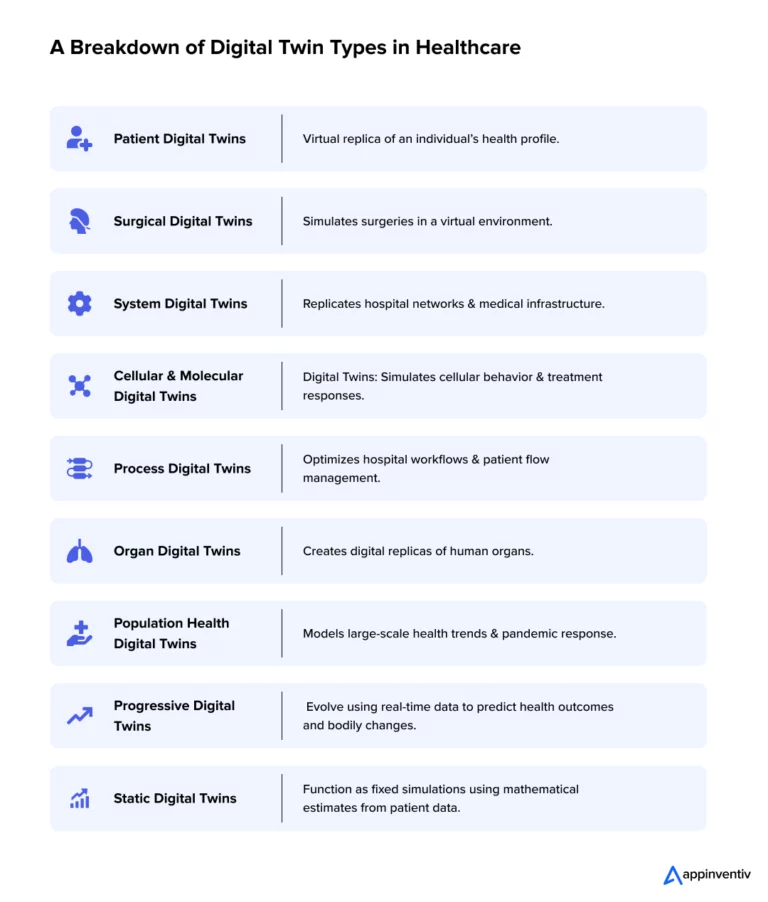
Patient/Person or Body System Digital Twins (Autonomous Digital Twins)
Patient digital twins create a virtual model of an individual’s health profile by integrating data from electronic health records, wearables, and imaging technologies. These digital replicas enable precision medicine, chronic disease management, and proactive healthcare interventions.
Surgical Digital Twins
Surgical digital twins revolutionize preoperative planning by allowing surgeons to simulate complex procedures in a virtual environment. This technology is particularly beneficial for robot-assisted and minimally invasive surgeries, enhancing precision and patient safety.
System Digital Twins
System digital twins replicate healthcare infrastructure, including hospital networks, medical devices, and supply chains, to enhance operational efficiency. These models are instrumental in predictive maintenance, preventing costly equipment failures before they happen.
Cellular & Molecular Digital Twins
Cellular and molecular digital twins are transforming AI-based drug discovery and genomics by simulating cellular behavior and treatment responses at a microscopic level. Researchers use these models to study disease progression and test drug efficacy before clinical trials, making digital twin medicine a game-changer in personalized treatment development.
Process Digital Twins
Process digital twins streamline hospital workflows, optimize patient flow, and improve overall healthcare logistics. These models help administrators identify inefficiencies and enhance resource allocation.
In emergency departments, for instance, a digital twin hospital can simulate various patient arrival scenarios, enabling hospitals to optimize triage processes, reduce wait times, and enhance real-time operational efficiency.
Organ or Smaller Unit Digital Twins
Organ digital twins replicate specific human organs or body parts to simulate and analyze how they respond to medical interventions. These models are crucial in personalized healthcare treatment planning, particularly in cardiology, nephrology, and gastroenterology.
Population Health Digital Twins
Population health digital twins analyze large-scale health data to predict disease outbreaks, enhance epidemic response strategies, and optimize public health policies. Governments and healthcare organizations use these models to simulate virus spread, plan vaccination campaigns, and allocate medical resources effectively.
During the COVID-19 pandemic, digital twins played a key role in forecasting infection trends and supporting data-driven decision-making for public health management.
Progressive Digital Twins
Progressive digital twins rely on data through time to create an intelligent learning system demonstrating how a physical entity (such as a body) transforms and forecasts potential future outcomes. They resemble digital versions of individuals that illustrate changes in molecules’ bodily processes and conditions (like aging) as time passes.
For example, researchers are developing three-dimensional brain cell models in laboratories to examine how the human brain operates and replicate disorders like Alzheimer’s, ALS, and microcephaly.
Static Digital Twins
A static twin resembles a standard simulation where experts examine things without live connections. It relies on math based on estimates to work things out. This static twin stems from information gathered by sensors that monitor a real system. In essence, static twins are mathematical models created from patient data. For example, Philips developed a static twin called HeartNavigator.
Key Technologies Used in Digital Twins for Healthcare
Various technologies are used to gather patient data when developing and deploying Digital Human Twins (DHTs). Digital health sensors and devices gather information directly from the patient and/or surroundings, and afterwards, they transmit and store it in real time in the IoT cloud. Here’s the list of the key technologies used in digital twins:
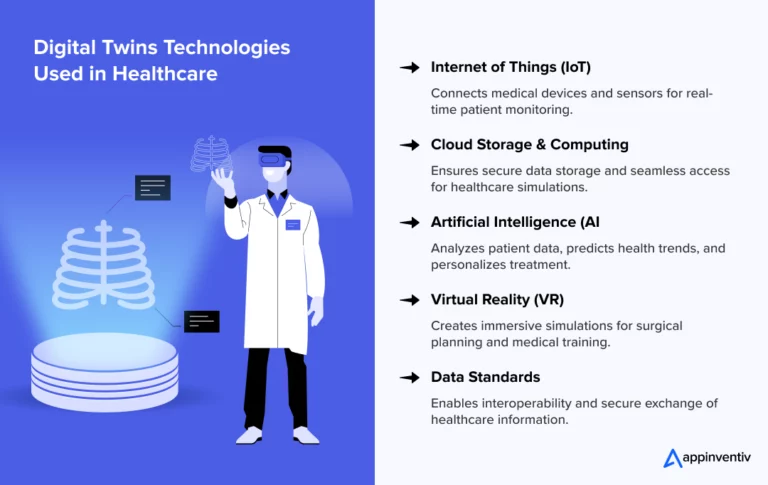
Use Cases of Digital Twins in Healthcare
The digital twin applications in healthcare cover many areas within patient care and hospital/medical services. Digital twins are becoming increasingly popular, and this section identifies important applications that help improve medical services and patient care.

Clinical Trials and Drug Discovery
The digital twin healthcare use cases present a novel way of dealing with the ethical and logistical problems surrounding clinical trials and drug development. These virtual models simulate complicated biological processes and responses of the human body.
Researchers can use these models extensively to test possible treatments and pharma compounds. It speeds up the trial process while reducing risks from conventional human or animal trials, making drug development approaches safer and quicker.
Patient Remote Monitoring
Digital twins have become an invaluable tool for monitoring the patient’s well-being at a remote distance and providing appropriate care or treatment for patients. Such capability is especially useful for people living in remote areas and those with mobility difficulties.
In other words, with these virtual versions, doctors can always check live data to determine if there are any deviations from the normal to take timely measures and implement a preventive approach in medicine.
Customized Medicine
The medical digital twin is one of the most advanced approaches to patient care. By leveraging extensive patient-specific information, these digital replicas are used to determine a personalized treatment plan that considers one’s unique health conditions, genetics, lifestyle, and specific medical needs.
This individualized approach ensures high treatment efficiency and reduces the risk of adverse reactions or ineffective measures. Thus, using digital twin medicine can lead to positive outcomes and improve patients’ quality of life.
Surgery Planning
The introduction of digital twins in healthcare has completely revolutionized surgical planning and preparation. By developing detailed 3D representations of each patient’s anatomy, medical professionals can now perform virtual surgery, anticipate and reduce challenges, and optimize the surgical plan.
This elaborate pre-operative planning ensures that complications are minimized, operating time is minimized, and homicidal accuracy is placed on surgery and postsurgical recovery.
Epidemic Management
The effects of digital twins on the healthcare sector can be observed during the control of the spread of pandemics such as COVID-19. Digital twins can help medical professionals to make data-driven decisions by utilizing huge datasets such as social gathering patterns, density, and availability of healthcare facilities. They assist in maximizing the allocation of resources, as well as putting in place effective containment measures.
This data can help medical professionals to understand the different factors which affect the dissemination of the disease and take proactive steps to curb the eventual propagation of infectious diseases by altering a number of parameters.
Prosthetics and Implants
The creation and installation of prosthetics and implants for patients with specific anatomical needs is a novel practice that embraces the use of digital twins as a means of providing the best fit and functionality of the devices.
To illustrate, through the creation of digital copies of the damaged body parts of patients, health care specialists will create state-of-the-art prosthetics and implants that are immensely precise when it comes to the anatomy of the individual patients, thereby making the patient comfortable and mobile.
These digital manifestations can also be used to simulate the movement as well as the rehabilitation activity in the post-procedure, and so the physiotherapists can prescribe custom rehabilitation programs to accelerate the healing process and enhance the lives of the patients.
Medical Device Development
The aspect of digital twinning in medical equipment development offers full virtual testing and research. Using a medical digital twin, developers will be able to check the impact of design changes, test various operating scenarios, and predict potential failures without carrying out the production of real units.
These digital versions of medical devices allow for speeding up innovation, lowering the cost of development, as well as improving the reliability of the device, and eventually creating safer and more effective medical solutions.
Digital twins implementation in healthcare allows developers to deliver safe and high-performing devices that are compliant with strict safety standards, ensuring improved patient care and healthcare outcomes.
Hospital Operations
Digital twin hospital technology facilitates the development of virtual versions that can be used to assess and optimize different elements of healthcare administration. Hospital managers can leverage digital twins to evaluate resource effectiveness, improving bed management, staff scheduling, and operating room utilization.
In addition, the features of the digital twin technology in healthcare provide a safe ground for assessing the effects of changes on systems’ performance and make it possible to adopt preventive measures in the hospital environment. Hospitals can simulate possible operating conditions to make advanced plans for risk prevention.
Advanced Digital Twin Use Cases in Healthcare
As digital twin technology continues to evolve, its applications in healthcare are expanding beyond traditional uses. These advanced implementations drive innovation in patient care, treatment planning, and operational efficiency. Let’s have a look at those.
Bio-Manufacturing
Facilitates precise modeling of biological processes for drug development, tissue engineering, and regenerative medicine. This accelerates production while ensuring product safety and quality.
Individualized Homeostasis Monitoring
Continuously tracks physiological data to detect imbalances early, enabling timely intervention. This personalized approach helps maintain stability in a patient’s health.
Cancer Management
Develops virtual tumor models to analyze treatment responses, allowing for more precise and personalized cancer therapies. This approach enhances treatment effectiveness and improves patient outcomes.
Cardiovascular Disease
Creates digital heart models to study disease progression, predict risks, and personalize treatments. This technology aids in early diagnosis and more effective intervention strategies.
Immune Responses
Simulates the body’s immune reactions to infections, vaccines, and treatments, enabling better disease management. This helps optimize therapies for autoimmune and inflammatory conditions.
Real-World Examples of Digital Twins in Healthcare
Digital twins in healthcare have seen massive utilization across various medical operations and functions, making a significant impact. Here are the top real-world examples of healthcare digital twins, showcasing innovative approaches transforming patient care and healthcare administration.
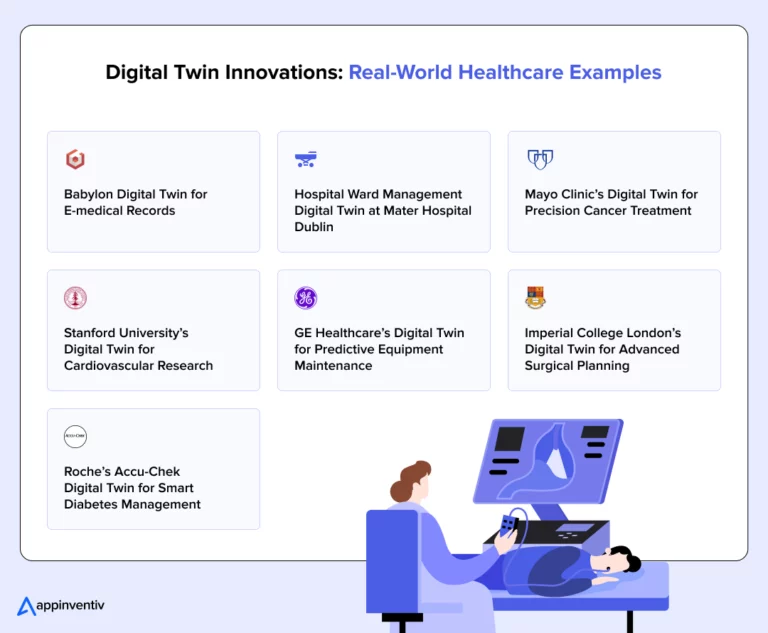
1. Babylon Digital Twin for e-medical Records
Babylon Digital Twin is the leading platform that helps individuals see the whole picture of their medical records and other health information. The system provides essential information regarding organ status and predisposing factors by employing advanced AI technology coupled with sophisticated deep learning techniques.
Currently, the platform focuses on only 20 diseases, but its expansion to capture more than 80 diseases is anticipated. Babylon’s Digital Twin confirms the increasing role of individual health data that enables people to stay on top of their health and well-being.
2. Hospital Ward Management Digital Twin at Mater Hospital, Dublin
Mater Hospital Dublin is an example of the transformative nature of healthcare digital twins that enhance the smooth functioning of hospitals and healthcare facilities. Mater Hospital Dublin utilized 3D digital replicas to critically evaluate its daily ward operations to improve the radiology department. As a result, a significant reduction in patient wait time for critical CT and MRI scans marked a real improvement in patient experience under the digital twin initiative.
Integrating workflow-simulated digital twins at the Mater Hospital led to a decrease of about 240 minutes in the wait time for CT or MRI scans. Such optimization contributed to shorter patient turnaround times, increasing MRI and CT scan capacities by 32% and 26%, respectively.
3. Mayo Clinic’s Digital Twin for Precision Cancer Treatment
Mayo Clinic is using digital twins to create patient-specific tumor models, enabling oncologists to simulate various treatment options and administer them. This precision, tailored to the individual, reduces trial-and-error in cancer treatment, resulting in more effective treatments and better patient outcomes.
The use of digital twins in healthcare can predict a tumor’s response to different treatments, help doctors refine their treatment plans, and prevent unnecessary side effects by combining AI with real-time patient data. This innovation improves oncology accuracy, increasing patients’ survival rates and quality of life.
4. Stanford University’s Digital Twin for Cardiovascular Research
Stanford University has created digital analogs of the human heart that represent cardiovascular diseases with the help of digital twins. The models assist cardiologists to determine the effects of various treatment protocols, and this translates to increased accurate and effective interventions.
With the addition of patient-specific information, such as imaging, genomics, and wearables, these digital twins can give a more in-depth overview of the heart conditions, thereby enabling them to be treated individually. These models have been employed by researchers to model the implantation and drug behavior of the heart, replicating the effects of the heart during invasive procedures and enhancing cardiac health over the long term.
5. GE Healthcare’s Digital Twin for Predictive Equipment Maintenance
GE Healthcare applies digital twins to track the performance of medical imaging machines (MRI and CT scanning) in real-time. Hospitals can be aware of anticipated failures prior to their occurrence and thus they will be able to provide timely maintenance, reduce downtime, and enhance patient care.
This will increase the longevity of vital medical equipment and aid in lowering the operational expenses through the occurrence of unforeseen breakdowns. Hospitals that did use the digital twin technology developed by GE have indicated that the number of disruptions caused by equipment has decreased considerably, which has allowed the hospitals to continue with the diagnostics and treatment of the patients.
6. Imperial College London’s Digital Twin for Advanced Surgical Planning
Imperial College London has been the first to apply the use of digital twins in complex surgeries, such as brain and orthopedic surgeries. Using the 3D models of the patients, the surgeons will be able to simulate the procedures using a virtual environment before they cut the real patients.
The strategy will increase the precision of surgical treatment, as the medical staff can improve the techniques, foresee complications, and make the strategy more efficient. Consequently, the digital twin technology could lead to considerable patient outcomes, lower risks in surgery, and a shorter patient recovery period.
7. Roche’s Accu-Chek Digital Twin for Smart Diabetes Management
The Accu-Chek by Roche combines the technology of the digital twin and glucose monitor that is connected to the internet so that diabetics can better control their diabetes. Through constant acquisition of real-time patient information, AI-assisted digital twins anticipate changes in glucose levels and prescribe the appropriate dosage of insulin.
This practice has enhanced compliance with treatment by the patients and minimized the threat of complications caused by diabetes, such as cardiovascular disease.
At Appinventiv, we worked with DiabeticU, a smart diabetes management app that enables users to have more control over their health. It allows effortless management and monitoring of diabetes and proactive management due to personalized tools and easy integration with wearable devices.
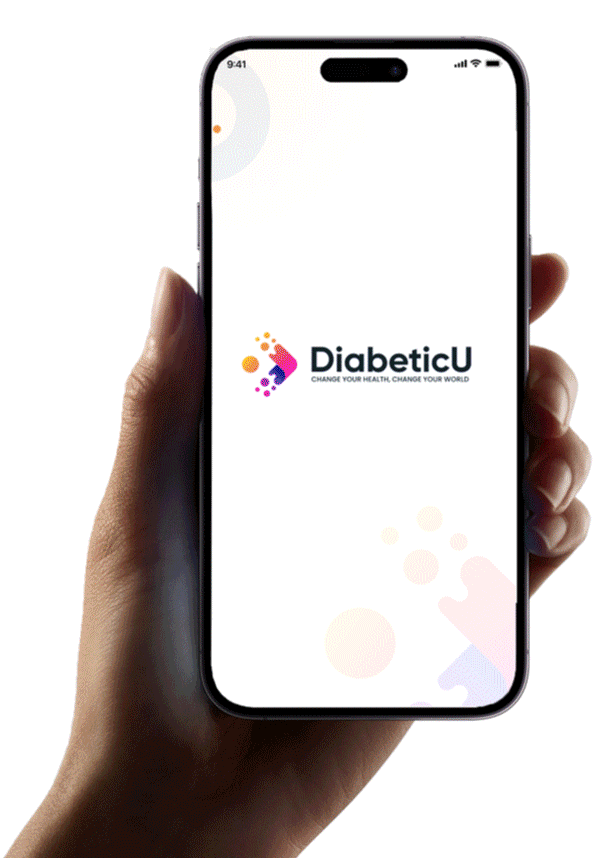
This innovative application has eased the process of managing diabetes. DiabeticU has transformed the management of diabetes by combining real-time data with personalized health insights, which enhances health results and the quality of life of the users.
Advantages of Digital Twins Technology in Healthcare
The usage of digital twins in healthcare is widespread. It can even create a digital model of the human body. With that said, here are some key advantages associated with the implementation of digital twins in healthcare:
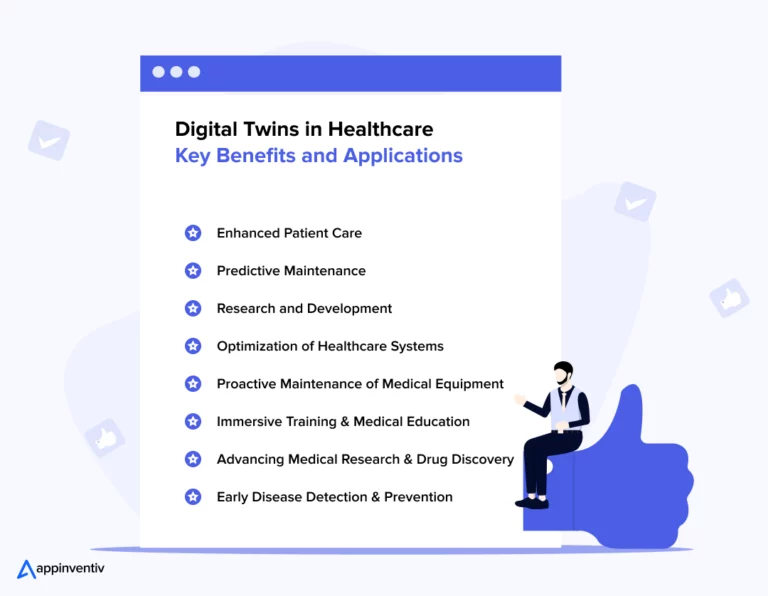
Enhanced Patient Care
A doctor could simulate treatments for the patient using their digital twin, helping make important decisions before physically carrying out treatments on the person. Such an approach aims to make procedures safer while raising the standard of care.
Predictive Maintenance
Digital twins could be used to predict failure scenarios and perform predictive maintenance of key medical devices in healthcare. This will enable healthcare providers to track device performance continuously to foresee any breakdowns that would otherwise occur during crucial medical work processes.
Research and Development
Digital twinning is an important tool in medical investigations. These virtual replicas act as platforms for carrying out a host of research experiments and probing into the intricacies surrounding genetic disorders. This can go a long way in transforming healthcare approaches and medical treatment procedures, especially for rare and complex cases.
Optimization of Healthcare Systems
Digital twins help healthcare facilities pinpoint operational inefficiencies and bottlenecks in their systems. Through this proactive analysis, managers can maximize resources, thus enhancing patient flow and service delivery.
Proactive Maintenance of Medical Equipment
Digital twins in healthcare enable continuous monitoring of critical medical devices, predicting potential failures before they occur. This allows for timely maintenance, reduces equipment downtime, and ensures seamless medical procedures without unexpected disruptions.
Immersive Training & Medical Education
Medical students and healthcare professionals can gain hands-on experience through digital twin simulations, replicating complex surgical procedures and human anatomy.
This interactive learning approach enhances skill development, reduces medical errors, and refines surgical precision.
Advancing Medical Research & Drug Discovery
Digital twins serve as a virtual testing ground for medical research, enabling scientists to model disease progression, analyze genetic disorders, and simulate drug interactions. This accelerates the development of new treatments, particularly for rare and complex conditions.
Early Disease Detection & Prevention
With continuous monitoring and predictive analytics, digital twins can detect early signs of diseases before symptoms appear. This proactive approach allows for timely interventions, reducing complications in chronic conditions such as diabetes, cardiovascular diseases, and cancer.
Also Read: How can digital twin technology help your business grow?
How are Digital Twins Created in Healthcare?
A digital twin in healthcare is built on a clear understanding of the system it must mirror, whether it concerns patients, clinical routines, or hospital operations. The aim is to create a dependable model that supports safer decisions and sharper forecasts. Here is a step-by-step process that shows how such a system comes together.
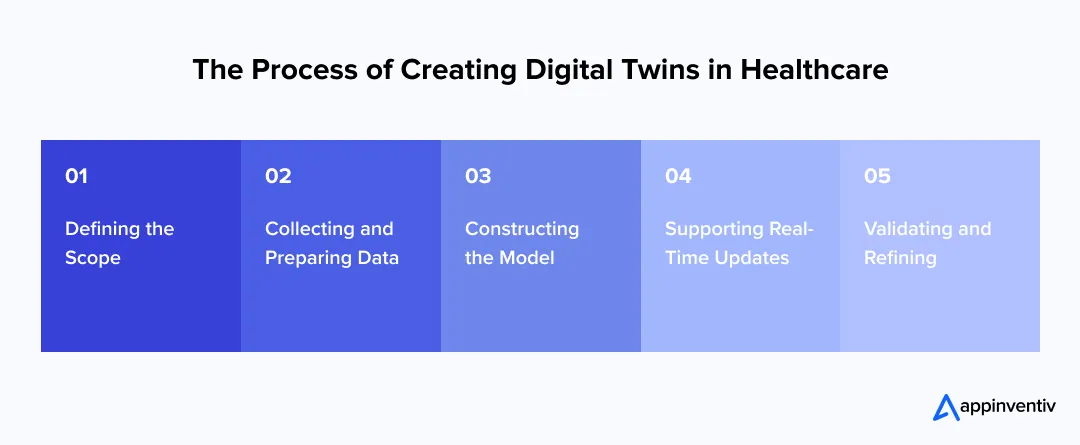
Defining the Scope
A project begins by clearly outlining what the digital twin is supposed to represent. That might be one patient, a whole clinical pathway, or maybe just a department’s day-to-day work. Teams figure out the boundaries, the objectives, and just how much detail is needed to get results that matter.
These decisions, in turn, really shape the timeline and technical expectations. Also, this early stage helps everybody frame how this digital twin for healthcare will actually be used once it’s up and running.
Collecting and Preparing Data
Engineers gather information, which comes from clinical records, imaging files, monitors next to the bed, lab systems, and even how the facility operates. They check each source for accuracy and completeness; weak inputs, after all, will really mess up the final model.
Then they align the data into a common structure, enabling comparison and analysis. Historical behavior gives them a baseline, but the latest activity reflects present conditions. This organized foundation is what later makes a reliable digital twin health model possible.
Constructing the Model
Developers choose methods that fit the goal, whether they need statistics, physics-based simulations, or machine learning technology. They built the model so it truly reflects the relationships they found in the data they prepared.
Trial runs quickly show where it’s working right and where they need to make revisions. They keep tweaking the structure until the model responds realistically. The result is a working representation that’s ready for real-time interaction.
Supporting Real-Time Updates
Once the model settles down, they connect it to a continuous flow of data from sensors, devices, and operational systems. These updates are what allow the twin to reflect changes in workflow, patient status, or environmental conditions right now.
A setup that’s this dynamic is great for monitoring and forecasting, which is way more useful than just simple record-keeping. This step turns a static model into a truly practical digital twin healthcare tool used every day in making decisions.
Validating and Refining
Teams compare the twins’ output with real outcomes just to check its accuracy. Any discrepancy means they need to adjust the model or the data feeding it.
Validation keeps going until the performance falls within an acceptable range for clinical or operational use; only then is the twin put to work for scenario testing, planning, or helping patients. Ongoing review is how they keep the twin dependable as systems keep changing.
Challenges of Adopting Digital Twin Technology in Healthcare
Digital twin for healthcare industry presents several challenges that must be addressed with caution when implemented at every step. Here are some of the key challenges of digital twin technology in healthcare and solutions to overcome them:
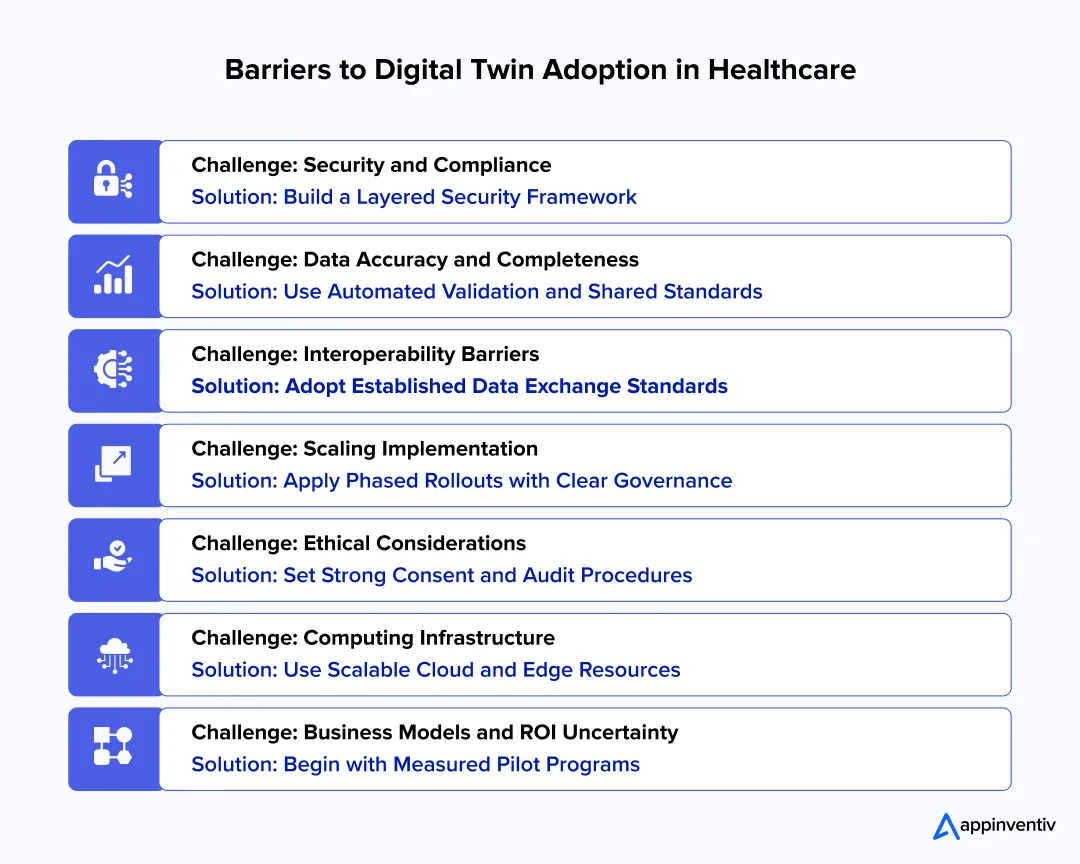
Security and Compliance
A digital twin for healthcare industry needs huge amounts of sensitive records, so protecting that information is absolutely essential. Hospitals have to guard against data breaches, and they must meet regional regulations to keep the public’s trust.
Solution: Build a layered security framework. This means encrypting data when it’s just sitting there and when it’s moving around. Set up strict, role-based access rules, do penetration testing all the time, and keep training the staff. You need to pair all of that with scheduled compliance reviews to protect things long-term and reduce exposure to new problems.
Data Accuracy and Completeness
A model is only valuable when the information you put into it is accurate and complete. If you have inconsistent medical histories, missing genetic data, or just irregular readings from a device, the reliability goes way down. Getting high-quality inputs requires disciplined, regular processes that check and validate information from every source. This improves stability and is crucial for using digital twins in clinical trials, where everything has to be precise.
Solution: Bring in automated checks for validation. Make sure everyone uses shared data definitions across all departments. Use collection tools that are integrated so they limit the mistakes people make manually. Also, add periodic quality assessments and routines to fix things, which helps keep accuracy high as new data comes in.
Interoperability Challenges
Health facilities often use different software systems that connect with each other well. That makes the information flow slow and cuts into the value of having one unified model. A coordinated approach using standard formats and compatible protocols lets data move cleanly across systems. This ultimately gives the model a clearer picture of the real-world environment.
Solution: Adopt standards that are already set up, like FHIR and HL7. Use integration engines to hook up older systems, and set up governance groups to watch over data consistency. Doing these things helps cut down on long-term maintenance headaches and improves how everyone coordinates.
Scaling Implementation
Organizations can run into trouble when they try to move from small, early testing to widespread use. Growing requires steady integration, structured guidance, and readiness across a lot of departments. Without these steps, expanding can just strain the current operations. But with the right strategy, a digital twin in medicine can grow while still keeping patient care smooth.
Solution: Use phased rollouts and test each stage before moving on. Set up cross-functional teams so responsibility for decisions is shared. Apply one central framework that clearly sets the technical rules and review cycles. This method is the best way to keep things stable as more and more people start using it.
Ethical Considerations
Digital twin for healthcare system naturally brings up issues around consent, data rights, fairness, and who is responsible for decisions the twin helps make. Dealing with these matters early on helps reassure patients and clinicians that the model is following accepted practices. Being clear about ethics also leads to stronger adoption and reduces the chance of conflicts down the road.
Solution: Prepare detailed consent procedures. Do recurring audits for bias in the system. Keep transparent records of any decisions the model helps make, and involve ethics boards in major updates. This gives you a responsible structure that protects both the people receiving care and the institutions providing it.
Computing Infrastructure
High-performance models need strong processing power, reliable storage, and consistent network capacity. Some facilities might just lack the systems that can support continuous updates. Newer technology can lessen that pressure by doing some of the work closer to where the data is actually collected.
Solution: Use scalable cloud platforms for all the really complex processing. Put edge computing units close to the clinical devices, which cuts down on latency. And consider federated learning to limit how often sensitive information has to be moved around. These choices help keep things efficient while controlling how much infrastructure you actually need.
Business Models and ROI Uncertainty
Leadership often hesitates when long-term returns are hard to prove. If they don’t see clear evidence of financial or clinical gains, projects can easily lose steam. Careful, early evaluation supports better planning and much clearer communication with everyone involved.
Solution: Start with structured pilot programs. Track the operational and clinical improvements specifically. Build partnerships that share the cost and the know-how. Presenting measurable gains and documented case studies is what will truly help justify the investment and support steady growth.
The Future of Digital Twin Technology in Healthcare
The digital twin technology in healthcare will fill the gap between virtual and real-world patient care in the future. This technology will improve decision-making, streamline interventions, and restructure personalized medicine through intelligent, information-guided simulators of individuals and systems. Let’s look at what the future of healthcare digital twin beholds.
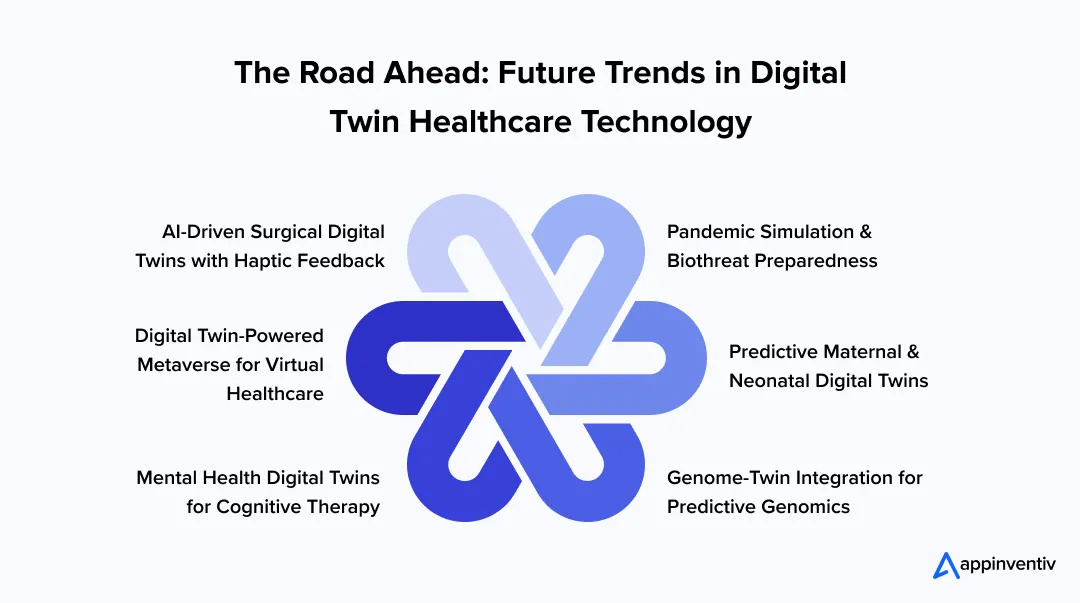
AI-Driven Surgical Digital Twins with Haptic Feedback
Surgical digital twins will be used, which will involve haptic feedback, whereby the surgeons will be able to sense the resistance and textures of the tissue during virtual simulation. This will enhance robotic-assisted surgery and accuracy in complicated surgeries.
Pandemic Simulation & Biothreat Preparedness
Governments and healthcare facilities will use digital twins at the population scale to model pandemic outbreaks and vaccine responses. AI digital twins in healthcare will streamline approaches to population health and emergency resource management.
Digital Twin-Powered Metaverse for Virtual Healthcare
Digital twin in healthcare will be combined with the metaverse, forming a virtual clinic where physicians and patients engage in 3D environments. This will help improve remote consultations, diagnostics, and even AI-managed virtual surgeries.
Also Read: Exploring Metaverse in Healthcare: An Ultimate Guide
Predictive Maternal & Neonatal Digital Twins
Digital twins made by artificial intelligence will track the progress of the unborn baby and maternal health in order to forecast the risk of preterm birth, genetic diseases, and complications. It will enable early interventions and individualized prenatal care.
Mental Health Digital Twins for Cognitive Therapy
The digital twins based on AI will measure emotional conditions, stress, and neurological biomarkers to deliver individual therapy prescriptions. These models will improve cognitive therapy and support ongoing well-being monitoring through the use of AI in mental health treatments.
Genome-Twin Integration for Predictive Genomics
There will be integration of complete genetic blueprints in the digital twins to forecast diseases, drug reactions, and hereditary diseases. This will allow preventive healthcare policies that are specific to the genome of a person.
Let Appinventiv Be Your Partner in Digital Twin Adoption
The development of digital twins in healthcare is a game-changing technology that can transform how patients are cared for while enhancing operational effectiveness and various other processes.
Appinventiv, as a leading healthcare software development company, is at the forefront of this transformation, helping healthcare providers, med-tech companies, and startups integrate AI-driven digital twin solutions for enhanced patient care and streamlined operations.
With a strong track record in healthcare innovation, we have been successfully involved in different healthcare platforms like Health-e-People, a unified health data management platform, and Soniphi, an AI-powered bioacoustic wellness app.
Beyond our expertise in healthcare app development, we specialize in digital twin adoption, helping businesses optimize efficiency, ensure compliance, and deliver superior patient outcomes in an increasingly data-driven world.
Ready to bring the power of digital twins into your healthcare system?
Let’s turn innovation into impact. Connect with our experts today and take the next step toward smarter, data-driven healthcare.
FAQs
Q. What are digital twins in healthcare?
A. A digital twin technology in healthcare creates digital representations of real things or processes, such as patients, organs, and whole hospital environments. The process is done with the help of other modern technologies like IoT and AI.
Q. What are typical applications of digital twin technology in healthcare?
A. Digital twins are now widely applied in the healthcare field and offer clear clinical as well as operational value. The benefits of digital twins in healthcare and their practical uses include:
- Individual treatment planning with reference to patient-specific physiological and historical results
- Remote patient monitoring that facilitates the early identification of deterioration
- Preparation of surgery based on highly detailed anatomy models, which are patient-specific
- Patient flow, bed management, and resource allocation workflow optimization
- Anticipatory servicing of medical devices to minimize time lost
- Drug discovery and clinical trial simulation assistance using virtual biological responses modeling
Q. How does a digital twin work?
A. A digital twin operates by collecting physical world information and then applying it to create a virtual representation that is a reflection of a patient, device, or clinical setting. Upon the introduction of new information, the model changes and gets a better representation, enabling clinicians and administrators to research the existing conditions and predict the future.
This is the endless process of input, simulation, and refinement, which is the centre of how a digital twin aids dependable decision-making.
Q. What are virtual twins in healthcare?
A. A virtual twin is primarily a high-fidelity simulation used for visualization, training, and scenario planning. While it accurately represents a healthcare entity, it does not always incorporate live data updates like a digital twin.
Q. How is digital twin technology revolutionizing the healthcare industry?
A. Digital twin technology will transform healthcare by developing real-time virtual images of patients, clinical procedures, and medical systems. The models facilitate individualized treatment planning, early risk identification, and better clinical decision-making.
Hospitals have been able to apply the concept of digital twins to simulate operational states, handle surges, and enhance resource efficiency without interfering with the provision of care. The technology is also leading to the development of drugs faster because of the advances in in-silico testing.
Q. What are the top digital twin platforms for emergency planning in healthcare facility management?
A. Here are some of the major digital twin healthcare platforms:
- Simcad Pro (CreateASoft) to predict patient flow on demand and instant testing of scenarios.
- Smart Spatial to see campus-wide, evacuation modeling and simulation of mass casualties.
- Olinqua Digital Twin to predict bed shortages, staff limitations, and incident response requirements.
- Neuron Building to monitor key infrastructures in a hospital in case of an emergency.
- MOSIMTEC to model surgical planning, forecast ambulance response, and design contingency strategies for emergency situations.
Q. What is a twin health tech stack system architecture?
A. It is the full set of data pipelines, modelling tools, storage layers, and integration components that support the creation and operation of a digital twin. This architecture links data sources, analytics engines, and simulation models into one coherent framework.


- In just 2 mins you will get a response
- Your idea is 100% protected by our Non Disclosure Agreement.

How Much Does It Cost to Build a Healthcare App in Saudi Arabia? All You Need to Know
Key takeaways: Healthcare app costs in Saudi Arabia range from 112,500 SAR to 2,250,000+ SAR based on size and complexity. The type of app you build matters more to cost than anything else. Compliance, security, and scalability are built into the cost, not add-ons. Development and testing consume the largest share of the budget. Hidden…
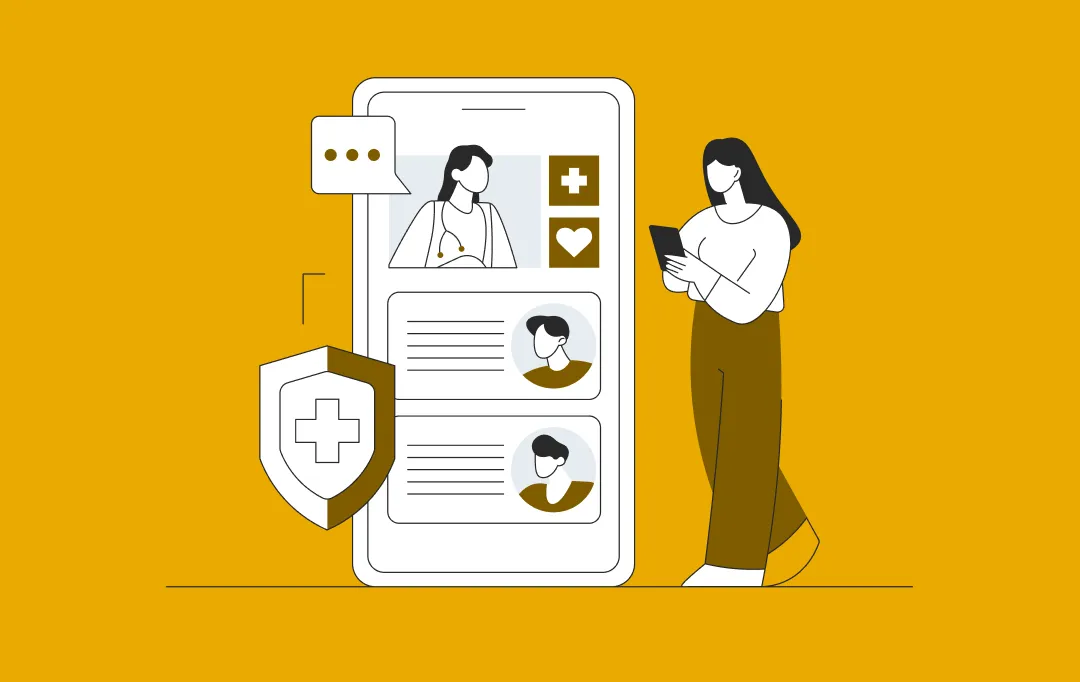
How Prescriptive Analytics Is Shaping the Future of Healthcare Management
A healthcare business doesn’t fall behind because its teams lack skill. It falls behind when decisions take too long. Bed allocation runs on yesterday’s data. Procurement reacts only when shortages hit. Care managers step in after a patient is already at risk. And leadership gets a picture of what’s happening only after the quarter closes,…
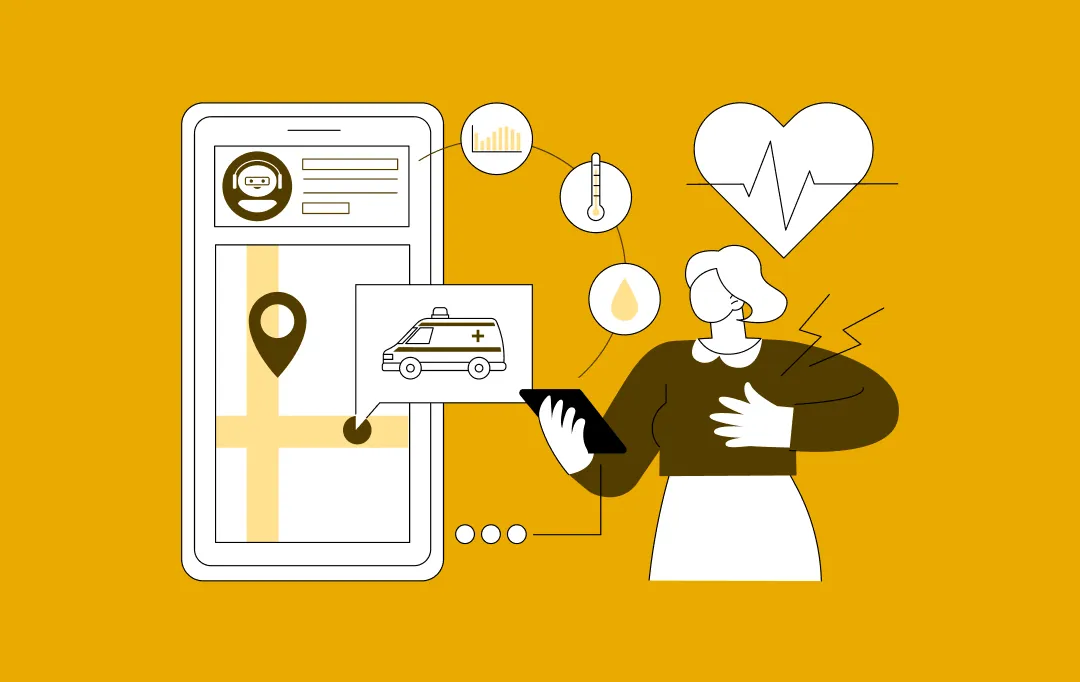
How to Build an Urgent Care App? A Step-by-Step Process, Features and Costs
Key takeaways: With more people turning to digital healthcare, the urgent care app market is expected to touch $3.1 billion by 2024 and continue growing fast through 2030. Apps that offer easy scheduling, video consultations, EHR access, and quick insurance handling tend to attract more users and keep them coming back. Developing an urgent care…
